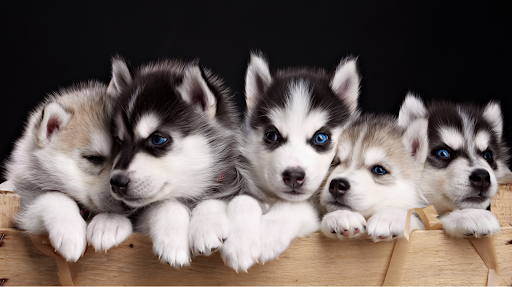Siberian Husky at 2 Months: Understanding Their Unique Needs
Welcoming a Siberian Husky into your home at two months old marks the beginning of a unique and rewarding journey. This critical stage of their development demands special attention and care. From nutrition to socialization, understanding the distinctive needs of a Siberian Husky puppy is essential for fostering a healthy and happy companion.
Physical Development
The physical development of a two-month-old Siberian Husky is both rapid and remarkable. At this age, they typically weigh between 10 to 15 pounds, showcasing a steady growth curve since birth. Their coat begins to develop the characteristic thick, double-layered texture, with the initial signs of the classic Husky color patterns and markings becoming evident.
As they progress through this stage, their physical coordination and strength improve notably. They start to exhibit greater control over their movements, transitioning from the unsteady toddles of early puppyhood to more confident and exploratory actions. This period is crucial for their overall physical development, setting the foundation for their future agility and strength.
Nutritional Requirements
At two months old, Siberian Husky puppies are transitioning from mother’s milk to solid food. A balanced diet is crucial to support their rapid growth. Consider a high-quality puppy food rich in protein and fat. Here’s a table outlining a sample feeding schedule:
| Time | Meal Type | Quantity |
| 8:00 AM | Dry Puppy Food | 1/2 Cup |
| 12:00 PM | Wet Puppy Food | 1/4 Cup |
| 4:00 PM | Dry Puppy Food | 1/2 Cup |
| 8:00 PM | Wet Puppy Food | 1/4 Cup |
Socialization and Training
Early socialization is key to shaping a well-behaved adult Siberian Husky. Introduce your puppy to various people, environments, and experiences. Basic training should commence, focusing on commands like sit, stay, and recall. Create a consistent routine for training sessions to instill discipline. A training progress table can help track achievements:
| Week | Command Taught | Progress |
| 1 | Sit | Mastered |
| 2 | Stay | In Progress |
| 3 | Recall | Not Started |
Physical Exercise
Siberian Huskies are known for their boundless energy, even at a young age. Regular exercise is crucial to prevent boredom and destructive behavior. Incorporate both mental and physical activities, such as puzzle toys and short walks. Adjust the intensity based on your puppy’s energy levels. A weekly exercise log can help monitor their activity:
| Day | Activity | Duration |
| Monday | Walk | 20 minutes |
| Wednesday | Playtime in the Yard | 15 minutes |
| Friday | Puzzle Toy | 10 minutes |
| Sunday | Hiking Adventure | 30 minutes |
Health Care
Siberian Huskies are generally robust, but routine veterinary care is essential. At two months, schedule vaccinations and regular check-ups. Keep a health record to track vaccinations, deworming, and any health concerns. Here’s a basic health log template:
| Date | Veterinary Visit | Vaccinations | Notes |
| 2 Months | First Check-up | Distemper, Parvo | Healthy and Active |
| 2.5 Months | Follow-up | Bordetella | Minor Ear Infection |
| 3 Months | Booster Shot | Leptospirosis | Resolved with Medication |
Grooming and Hygiene
Siberian Huskies have a thick double coat that requires regular grooming. Brush their coat at least twice a week to prevent matting and reduce shedding. Additionally, introduce basic grooming practices, such as nail trimming and ear cleaning. A grooming log can help maintain consistency:
| Date | Grooming Session | Activities |
| Week 1 | Brushing | 15 minutes |
| Week 2 | Nail Trimming | 10 minutes |
| Week 3 | Coat Inspection | 20 minutes |
Behavioral Traits
At two months old, Siberian Huskies exhibit a range of behavioral traits that reflect both their breed characteristics and their developmental stage. Known for their high energy levels and playful nature, these puppies are typically very curious, eager to explore their surroundings. This exploratory behavior is coupled with a burgeoning sense of independence, which can sometimes manifest as stubbornness, especially during training sessions.
These young Huskies also begin to show the sociable and friendly demeanor that the breed is known for. They enjoy interacting with people and can be quite affectionate with their family members. However, their playful and sometimes mischievous antics require patient and consistent training to ensure they learn appropriate behavior. This stage is vital for setting the groundwork for future social interactions and behavioral patterns.
Conclusion
Understanding the unique needs of a Siberian Husky at two months is fundamental to raising a healthy and happy companion. From nutrition to grooming, a well-rounded approach ensures their physical and mental well-being. By incorporating these practices and maintaining detailed records, you’re not only providing excellent care for your puppy but also setting the foundation for a strong lifelong bond.
Join the YourPetLand Community Today!
Don’t miss out on the adventure of raising your Siberian Husky puppy! Join YourPetLand for exclusive tips, expert guidance, and a supportive community of fellow Husky lovers. Let’s embark on this exciting journey together!


